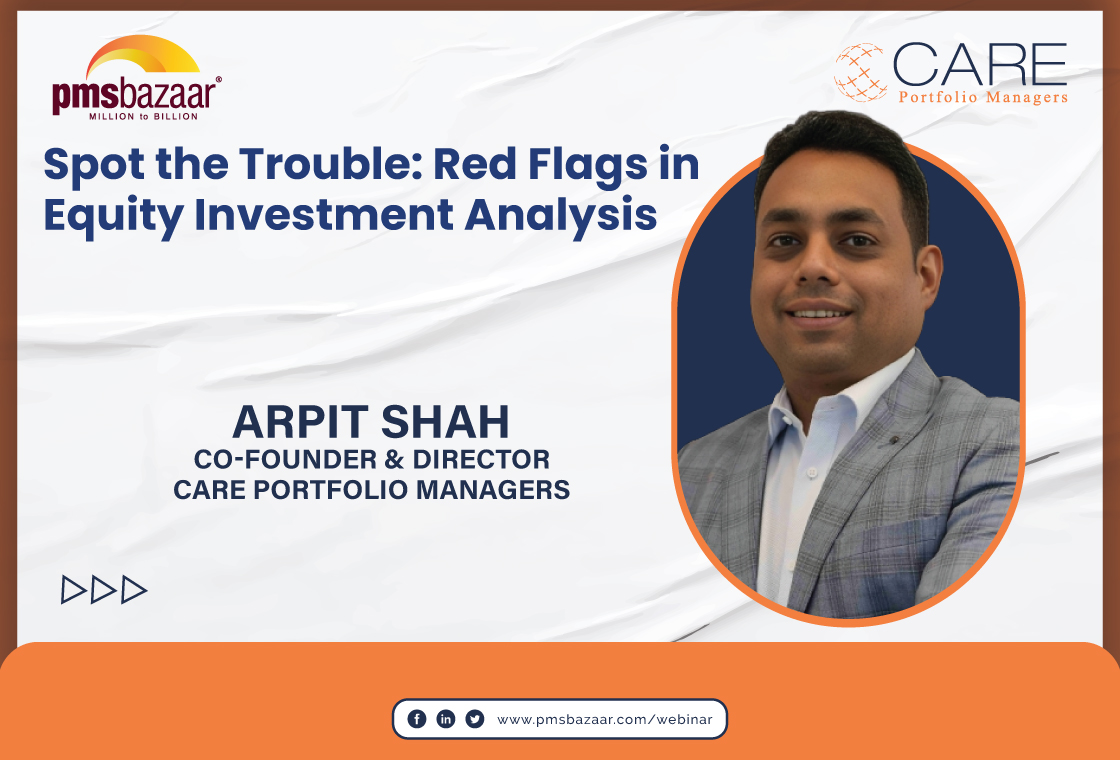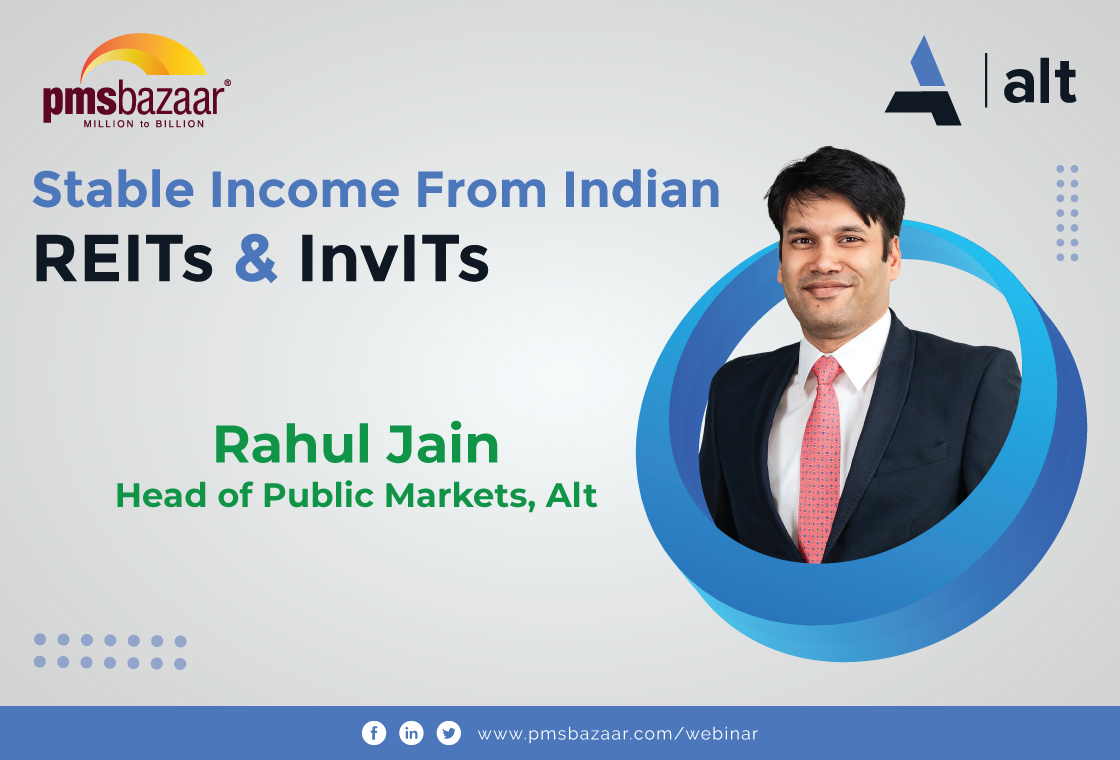When comes to investments, there are different types of investment products that are available in the market. Likewise, when we talk about PMS, there are multiple PMS offerings that are available. However, not all investors have the same kind of objective. Some are aggressive and some are on the conservative side. Therefore, it is important for you as an investor to try and understand the philosophy of investment products and if that philosophy suits you then that product can do wonders for you.

Mr. Mayur Shah, Deputy Vice President and Portfolio Manager, Anand Rathi Advisors Ltd., discusses the different types of PMS portfolios that he has, as Portfolio Manager, built based on the concept of “Global to local opportunity through PMS”. This gives an insight into the myriad of investment opportunities and returns that PMS has to offer. The key takeaways of the discussion are as follows.
According to Mr. Shah, “When we talk about global to local opportunity, we talk about investing in global conglomerates listed in India but in which the foreign shareholding is over 50% and/or the management control is bestowed in a foreign company, and/or the technological know-how is brought in by the foreign company”.
Now, why opt for such a portfolio? The objective is to have an MNC portfolio that gives a linear return, slow and steady, but a consistent return, and has the least volatility among all equity products that are available in the market. The basic idea is to only invest in those companies that are listed in India. These companies have set up their offices in India, have their manufacturing units in India, their end-users are mostly Indians, and are doing very well in terms of revenues and growth.
MNCs in India have several advantages such as economies of scale, huge R&D investment, decades of experience, access to under-priced labour in developing countries and R&D capabilities in developed countries, innovation and use of advanced technology and know-how, and their brand recall and bargaining value of the brand is very strong.
In terms of corporate governance, these companies are rated high and very rarely have been known to be involved in corporate mismanagement or fraud of any kind. MNCs are known for their accountability and transparency with well-laid out policies, regulatory framework, internal regulations, and risk management. Hence, investors can be assured they will not be affected by any adverse impact on their investment in these MNCs.
Talking about MNCs' balance sheet, the majority of these companies are usually zero or low debt-equity companies with a primary focus on their cash flows. They concentrate on those businesses where the cash flow is very strong. They are cash-rich companies paying regular dividends. The returns ratio such as the return of equity (ROE) and return on capital employed ROCE are also very high. Hence, these MNCs can sustain themselves in any challenging or unpredictable business environment.
Another, objective of a PMS portfolio comprising MNCs companies in India is to beat the returns of the NIFTY 50:50 and NIFTY MNC indexes. As far as the strategy is concerned, it is a multi-cap strategy and the portfolio comprises small-, mid-, and large-caps companies. The current model client portfolio comprises 18 stocks, with most of the stocks given equal and sizeable weightage in the portfolio. The portfolio is well-diversified across market capitalization and sectors. In terms of returns - while the portfolio is giving slow and steady returns, they have been consistent over the years with an average CAGR expected between 15-20%, with the lowest possible volatility and strong resilience to any unforeseeable business challenges.
The portfolio has a single weight stock of a maximum of 15%; however, partial booking of profit is done whenever the overall weight of the single stock in the portfolio reaches close to 9-10% of the portfolio. Also, to optimise performance, partial and complete exists in losses are done depending upon market dynamics. Hence, this portfolio stands out in terms of better risk-adjusted return, with a moderate to conservative risk-return, but consistent returns.
While the majority of investors prefer conservative returns, there are investors looking at a balance of aggressive and conservative returns. For such investors, there is “impress portfolio” comprising 75-80% of MNC companies belonging to the mid- and small-cap size, having not less than 1000 crore market capitalisation. These mid- and small-caps are well-researched and the focus is on return optimisation by investing in growth enterprises with sound corporate track records and sustainable business models. Hence, the strategy followed is a balance between value and growth.
In terms of allocation within the portfolio, the bottom-top approach is followed. According to Mr. Shah, “Any fund manager will look at 4 key parameters - the past, present, future and corporate governance - while deciding on the investment allocation within the portfolio”. In the past, the fund manager tries to identify what kind of wealth creation has the company done for its shareholders, what kind of sales the business has seen, the working capital management, the margin improvement these companies have seen, the asset turnover, and the return ratio that the company has delivered in the past.
With regard to the present, the fund manager tries to understand what is the current strategy of the company, what is its leverage ratio, the future value addition that the company intends to offer, and in the future if there are challenges or shocks, whether the company’s balance sheet can absorb all those shocks or challenges.
As far as the future is concerned, the fund manager will look at the future earnings visibility of the company, capital expenditure activities, multi-year contracts, and other activities to meet future demands that the company may have to fulfill. The last parameter, corporate governance, the fund manager analyses if the management quality of the companies in the portfolio is sound enough.
The current model client portfolio comprises 19 stocks that are well-diversified across market capitalisation and sector. The earnings estimate growth for the next two years for the basket as a whole is around 34%. Hence, if the earnings are likely to move on the higher side, the share price will also move in tandem. Therefore, the return objective of the impress portfolio is more likely to be met. As far as the performance of this portfolio is concerned, the portfolio has given impressive returns of about 60%, irrespective of volatility in the market. In the last two years, CAGR was around 46.6%. Like the MNC portfolio previously discussed, to optimise performance, partial booking of profit is done.
Moving forward, considering India’s current setup and future growth and opportunities, a new PMS portfolio has been initiated. This portfolio is called “Decennium Opportunity”. According to Mayur Shah, “India is going through a transformational change. Many sectors and industries and witnessing an industrial revolution at this point, and India is likely to leap forward into the global market. This aligns with the vision of the Indian government of seeing India being a global level supply partner”.
The word decennium means a decade, and in this case, it implies a decade full of opportunities, that is, big growth opportunities that investors can expect as an equity investor. The focus of this portfolio is on return optimisation by investing in a multi-cap portfolio of companies with good corporate governance, stable and improving margins with high ROE and ROCE, higher growth expectations, scalability of business, working capital efficiency, competitive advantage, strong emerging business, or companies entering into the next business upcycle.
That is, investing in companies that are likely to benefit from the industrial revolution, new-age businesses with favourable policies, companies that are showing visible signs of a turnaround with higher growth in the next business upcycle, and where the government is providing incentives and thrust to the growth of these companies. For instance, sectors such as electric vehicles, Robotics and AI, clean and green energy, e-commerce digital aggregators, defence and communication technology, among others.
Likewise, there are many other sectors that going through a transformation at this point and the idea is to invest in companies that seize opportunities at every level of emerging business, whose business models are able to adapt to changing business dynamics. Many segments and sectors are going through a consolidation phase and after a long time are showing significant potential. Examples, metals, realty.
There are some sectors that have already shown growth potential, and government is giving more thrust and push to these sectors to enhance their capacity and capability to become global supply partners. Sectors include chemical goods, IT, pharma, consumer durables, electrical goods, among others. The government feels incentivising these sectors can help India achieve their trillion-dollar Indian economy vision.
If this article has whetted your appetite for more, relive the entire session by clicking on the link below:
For more information, please contact info@pmsbazaar.com
Recent Blogs
.jpg)
Passively Active Investing — A Modern Investor’s Lens on ETF-Based PMS
PMS Bazaar recently organized a webinar titled “Passively Active Investing — A Modern Investor’s Lens on ETF-Based PMS,” which featured Mr. Karan Bhatia, Co-Founder and Co-Fund Manager , Pricebridge Honeycomb ETF PMs. This blog covers the important points shared in this insightful webinar.

Spot the Trouble: Red Flags in Equity Investment Analysis
PMS Bazaar recently organized a webinar titled “Spot the Trouble: Red Flags in Equity Investment Analysis,” which featured Mr. Arpit Shah, Co-Founder & Director, Care Portfolio Managers. This blog covers the important points shared in this insightful webinar.

Long-Only AIFs Rebound Sharply in October; Long-Short Strategies Lag Despite Lower Volatility
106 long-only AIFs averaged 3.68% vs 32 long-short AIFs at 2.7%; only 24–31% of funds beat key indices

Markets log strongest monthly gains in 7 months; PMS performance turns near-uniform in October
Nifty 50 TRI gained 4.62%, BSE 500 TRI rose 4.27%; 415 of 427 equity PMSes ended positive

How SMEs are Shaping India’s Investment Landscape?
PMS Bazaar recently organized a webinar titled “How SMEs are Shaping India’s Investment Landscape?” which featured Mr. Shrikant Goyal, Fund Manager, GetFive Opportunity Fund.

Stable Income from Indian REITs and InvITs
PMS Bazaar recently organized a webinar titled “Stable Income from Indian REITs and InvITs,” which featured Mr. Rahul Jain, Head of Public Markets, Alt.

5 Key Considerations Before Investing in AIFs in India
Alternative Investment Funds (AIFs) have emerged as a compelling option for sophisticated investors seeking diversification and potentially superior returns. But venturing into AIFs requires a clear understanding of their unique characteristics that go beyond simply knowing what they are and their categories.

How AIF can help in diversification?
Traditionally, Indian investors have relied on a mix of stocks and bonds to build their wealth. While this approach offers diversification, it can still leave your portfolio vulnerable to market fluctuations. Enter Alternative Investment Funds (AIFs), a dynamic asset class gaining traction for its ability to unlock diversification beyond the realm of conventional options.

